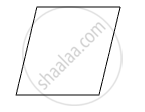Advertisements
Advertisements
Question
A boy of mass 40 kg runs up a height of 30 steps, each 20 cm high. Find:
(i) The force of gravity acting on the boy.
(ii) The work done by the boy against gravity. (Take g = 9.8 ms−2)
Solution
Given : m = 40 kg, g = 9.8 ms−2
Distance moved, d = 30 × 20 cm = 600 cm = 6 m.
(i) The force of gravity, F = mg = 40 × 9.8 = 392 N.
(ii) The work done by the boy, W = F × d = 392 × 6 = 2352 J.
APPEARS IN
RELATED QUESTIONS
Explain the motion of a planet around the Sun in a circular path.
'The position of the centre of gravity of a body remains unchanged even when the body is deformed'.
Following Fig shows piece of cardboard of uniform thickness cut into different shapes. Draw two lines to indicate the position of centre of gravity G.

Following Fig shows piece of cardboard of uniform thickness cut into different shapes. Draw two lines to indicate the position of centre of gravity G.

Following Fig shows piece of cardboard of uniform thickness cut into different shapes. Draw two lines to indicate the position of centre of gravity G.

A right-angled triangle cardboard piece is placed as shown in fig. 7. Redraw the diagram showing the relative position of the vertices of the triangle when it is suspended by a pin from the hole A. Explain why the position changes?

Even though the Tower of Pisa is leaning through an angle it does not fall.
Can the CG be situated outside the material of the body? Give an example.
Explain the term ‘centre of gravity’ of a body.
Mention the real-life applications of the center of gravity.
